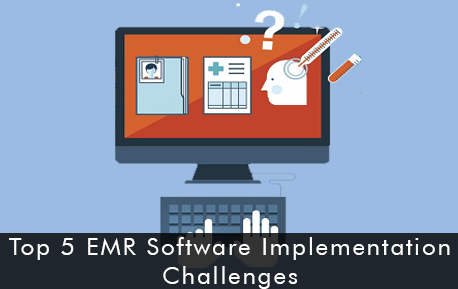The Meaningful Use (MU) incentives program has led to an enormous rise of Electronic Medical Records (EMR) software implementation in the healthcare practices. According to the Office of the National Coordinator (ONC), office-based adoption of EMR software has increased from 17 percent in 2008 to 83 percent in 2015 .
Although the number of EHR adoption continues to grow but practices still face many challenges during its implementation. Following are the top 5 EMR software system adoption challenges and tips on how to avoid these challenges:
High Implementation Cost
HealthIT.gov has conducted many studies that show us that the cost of buying and installing an EHR software system ranges from $15,000 to $70,000 per provider, depending on the kind of the software the practice uses i.e. on-site EMR or cloud-based EMR. These costs cover hardware, software, implementation assistance, training, and ongoing network costs. The cost of an Electronic Health Records (EHR) software is the top reason why practices hesitate before implementing an EHR. Physician Practices find partnering with the vendor that provides their Practice Management (PM) software because it’s more seamless and economical. There are various free and open source EMR software products available in the healthcare software market that physicians can try to determine whether they meet the requirements of the practice.
EHR software might not be suitable for the practice
After careful implementation, some practices may find that the EMR system just does not provide the flexibility or customization that they are looking for. Physicians find themselves helpless because they have already invested in software technology but cannot use it effectively. The best way to solve this problem is to make sure that each and every potential EHR/EMR software vendor provides an in-depth EMR demo regarding the features and functionalities of the software. All staff members must be able to test the software and provide input before actually buying it.
Difficult and Time-Consuming EHR Software Training
Vendors must be able to provide in-depth training for all physicians, practices that succeed with EMR software adoption are those that identify super-users who really take the time to get familiarized with the EHR and who can serve as a resource for physicians. Always be sure that your EHR system vendor specifies the type and duration of training that the employees will receive. This includes the training on all EMR software modules and templates including all the updates. The vendor should also provide an active support line that users can call when they have queries.
Challenging Usability
Some physicians simply would not want to use the EMR/PM technology either because they do not believe in its efficiency or they feel that it will decrease their practice’s productivity, or maybe perhaps they are intimidated by it. Practices must identify a top physician who knows how to use an EMR and can encourage others to implement the technology and feel more contended using the software.
Difficult to meet all Meaningful Use (MU) Requirements
It is challenging to meet the requirements and comply with Meaningful Use (MU). Healthcare practices whose EMR/PM software vendors are ready for Meaningful Use requirements sometimes fall behind because they do not run internal activities to make sure that they succeed. Those who miss deadlines will definitely get charged with penalties. The best way to avoid this problem is to assign someone the duty within the practice to oversee requirements, deadlines, and ongoing communication etc. with your vendor to avoid any unpleasant consequences.







